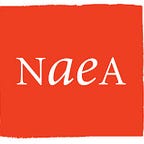Learning by Writing
Gallery Demonstration Lesson Plans and Reflections from the 2015 NAEA Museum Education Pre-Conference
There is an argument in academia that conferences are a waste of time. This argument posits that if an individual devoted an equal amount of time to writing as to attending sessions and networking, they would produce more substantive material that could be published and have greater potential impact on both an individual’s career as well as their field of expertise. In short, if you were to hole-up and write for four to seven days you might finally finish that article or book proposal. This line of thinking is admittedly extreme and framed within a paradigm where publishing is paramount, but it does beg the question:
How do conventions and the associated behaviors of presenting and networking advance a field in a way that is impactful and lasting?
This argument is even more provocative when contrasted with the field of art museum education. Historically conventions serve as the primary, and sometimes, the only professional development experience an individual participates in on an annual basis. Undoubtedly the informal and personal connections of a convention are invaluable; however, when it comes to the formal aspects of presenting it maybe time that we all reflect on the need for greater documentation within the field.
In the busy lives of museum educators, it can be difficult to take the time to document our work in a lasting format. But this act is important for our professional development. From an individual perspective writing has direct implications for career advancement because it provides a public record of the ideas and methods that one uses to address central concerns within the field. Writing stands to garner attention from colleagues within an institution as well as open doors to colleagues at other museums. For the field at large writing is important because it provides a robust foundation, new ideas, and new lenses through which to consider or challenge tried-and-true methods.
To that end, in March 2016, museum educators from across the country gathered in Chicago, IL, for the National Art Education Association National Convention, and as part of the Museum Education Division’s Pre-Conference, participated in gallery teaching facilitation and reflection sessions for peers. Twenty-one educators volunteered to try out a strategy, activity, or method for peers, and then take part in a reflective discussion about their practice. In contrast to years past, we then invited the gallery facilitators to capture their process and reflections in writing. Below you will find links to all the submitted gallery demonstrations.
We have multiple intentions in sharing these documents. Immediately, we hope these resources provide an opportunity to review and experiment with the instructional approaches shared at the Pre-Conference. Aspirationally, we hope these documents attest to the need for more writing about in-gallery instruction. This form of writing is distinct to our field. A larger discussion about the modes and benefits of documenting gallery teaching will provide yet another entry point for those interested in writing about their work.
Gallery Teaching Demonstration Synopses
Behind the Scenes: The Artist
Beth Foulds, Education & Programs Manager, Briscoe Western Art Museum
Creative Play in Family Gallery Learning
Liz Yohlin Baill, Manager of Family Gallery Learning, Philadelphia Museum of Art
Draw & Discuss: Experimenting with Duration-Based Sketching and Group Writing
Emily Cayton, Associated Educator for Teachers & Docents, The Contemporary Austin
Forced Fit: Making Meaning from Associations
Maria Iafelice, Docent Program Manager, Toledo Museum of Art
Frame of Reference: Investigating Information and Perception
Amy Boyle, Education Associate/Learning Through Art, Guggenheim Museum
Gaining Perspective through Sketching: Drawing in the Round
Jessica Sack, Jan and Frederick Mayer Senior Associate Curator of Public Education, Yale University Art Gallery
Marrying Strategic Questions with Learning Objectives
Karin Jacobson, Managing Educator, TEAM (Thinking Experiences in the Art Museum), Art Institute of Chicago
People, Places, and Things: Inventing Narratives Together
Mary Erbach, Assistant Director of Interactive Exhibitions, The Art Institute of Chicago
Play Meets Art: Gallery Engagement Activities for Young Visitors
Stephanie Stern, K-12 Programs Assistant Manager, Barnes Foundation
Puzzler: Fostering Flexible Thinking and Collaboration
Kate Blake, Manager of Curriculum, Toledo Museum of Art
Using Sketching to Access Modern Art
Liz Diament, Senior Educator and Manager of School Tours and Docent Programs, National Gallery of Art
